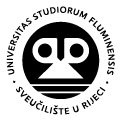HRZZ projekti
NPOO projekt
HRZZ projekt - WATPUR
Priprema poroznih tanko slojnih materijala za pročišćavanje vode koristeći tehniku Depozicije atomskih slojeva (ALD)
Voditeljica projekta: izv. prof. dr. sc. Gabriela AmbrožićSuradnici s Odjela za fiziku:
Dr. sc. Maria Kolympadi Markovic
Doc. dr. sc. Iva Šarić
Doc. dr. sc. Ivana Jelovica Badovinac
Doc. dr. sc. Robert Peter
Doc. dr. sc. Ivna Kavre Piltaver
Vanjski suradnici:
Prof. dr. sc. Mato Knez (CIC nanoGUNE, San Sebastian, Španjolska)
Dr. sc. Celia Rogero, Materials Physics Center (CSIC-UPV/EHU, San Sebastian, Španjolska)
Dr. sc. Maxim Ilyn (Donostia International Physics Center (DIPC), San Sebastian, Španjolska)
Izv. prof. Ivana Gobin (Medicinski fakultet, Sveučilište u Rijeci)
Prof. dr. sc. Dean Marković (Odjel za biotehnologiju, Sveučilište u Rijeci)
Doc. dr. sc. Karlo Wittine (Odjel za biotehnologiju, Sveučilište u Rijeci)
Sažetak projekta:
Cilj projekta je priprema novih fotoaktivnih keramičkih tankih filmova s kontroliranom debljinom i dobro definiranim poroznim strukturama s izrazitom primjenom za pročišćavanje vode od organskih i bioloških zagađivača. U projektu se istražuju novi pristupi u sintezi ovih materijala, koristeći tehniku Depozicije atomskih slojeva (Atomic layer deposition - ALD) u kombinaciji s visoko selektivnom „klik“ kemijom, koji će unaprijediti osnovna znanja i razviti inovacije u sintezi materijala za primjenu u pročišćavanju vode zelenim tehnologijama. Sintetski i post-sintetski procesi su osmišljeni za dobivanje materijala s naprednom funkcionalnošću koja će omogućiti: smanjenje troškova tehnologija pročišćavanja voda kroz primjenu solarne energije, selektivnu adsorpciju organskih i bioloških zagađivača, fotoinduciranu desorpciju organskih zagađivala, foto-induciranu razgradnju organskih onečišćujućih tvari i učinkovitu regeneraciju te ponovno korištenje tankoslojnih materijala. Ovi novi keramički materijali se razlikuju od tradicionalnih materijala i procesa za pročišćavanje i dezinfekciju vode upravo zbog sintetskih postupaka koje ćemo primijeniti, a koji će omogućiti narastanje potpuno novog tipa višenamjenskih keramičkih filmova deponiranih na biorazgradivom tekstilu / pamuku i anorganskim makro-poroznim podlogama. Spomenute karakteristike će proširiti potencijal keramičkih materijala u različitim smjerovima primjene: od dekontaminacije mora od naftnih izlijeva do sustava za pročišćavanje pitke vode.

Objavljen znanstveni rad u časopisu Journal of Environmental Chemical Engineering
Istraživački tim HRZZ projekta „Priprema poroznih tankoslojnih materijala za pročišćavanje vode koristeći tehniku Depozicije atomskih slojeva (ALD)“ objavio je novi znanstveni rad Superior UVA-photocatalytic antibacterial activity of a double-layer ZnO/Al2O3 thin film grown on cellulose by atomic layer deposition (ALD) u respektabilnom časopisu Journal of Environmental Chemical Engineering (Q1, IF (2019): 5,909).Sudjelovanje na konferenciji
Iva Šarić sudjelovala je na konferenciji 27th International Scientific Meeting on Vacuum Science and Technique koja se održala 9. i 10. rujna 2021. godine u Gozd Martuljek, Slovenija. Na konferenciji je prezentirala poster pod nazivom "Introducing the concept of pulsed vapor phase copper-free surface click-chemistry using the ALD technique".

Objavljen članak u časopisu Surfaces and Interfaces
Objavljen članak u časopisu Surfaces and Interfaces(Impact factor: 4,837, JCR 2020):
Ales Omerzu, Robert Peter, Daria Jardas, Iztok Turel, Kresimir Salamon, Matejka Podlogar, Damjan Vengust, Ivana Jelovica Badovinac, Ivna Kavre Piltaver, Mladen Petravic, Large enhancement of photocatalytic activity in ZnO thin films grown by plasma-enhanced atomic layer deposition
https://www.sciencedirect.com/science/article/abs/pii/S2468023021000614
Abstract:
In this work, we present a large, tenfold enhancement in the photocatalytic activity of thin ZnO films grown by plasma-enhanced atomic layer deposition (PE-ALD) at 100 °C, compared to values obtained for thin ZnO films deposited by a conventional thermal ALD method at the same temperature. Thus, we have demonstrated that we can deposit thin ZnO films using the PE-ALD method both at low temperatures and with a high photocatalytic ability. A number of structural (SEM, EDX, HRTEM, GIXRD, XRR, XPS, SIMS) and optical (UV-Vis, PL) experimental techniques have been employed to elucidate a possible physical origin of the observed remarkable difference in the photocatalytic activity of thin ZnO films grown by the PE-ALD method compared to those grown by the thermal ALD method.
Objavljen članak u časopisu Applied Surface Science
Objavljen članak u časopisu Applied Surface Science(Impact factor: 6,182, JCR 2019):
I. Šarić, M. Kolympadi Markovic, R. Peter, P. Linić, K. Wittine, I. Kavre Piltaver, I. Jelovica Badovinac, D. Marković, M. Knez, G. Ambrožić, In-situ multi-step pulsed vapor phase surface functionalization of zirconia nanoparticles via copper-free click chemistry
https://www.sciencedirect.com/science/article/abs/pii/S0169433220330117?via%3Dihub
Abstract:
We report on multi-step copper-free vapor phase azide-alkyne click reactions for the functionalization of metal oxide nanopowders, automated with the atomic layer deposition (ALD) technique. The synthetic approach consists of the following reaction steps: chemisorption of propiolic acid (PA) to ZrO2 from the gas phase, followed by the formation of a triazole ring through a click reaction with 1,4-bis(azidomethyl)benzene (BisA), and, in the final step, click-coupling of the pendant azide groups with a second dose of propiolic acid (PA). The chemical composition and nature of the chemical bonding in the samples obtained after each of the ALD processing steps were investigated in detail by ATR-FTIR and XPS. As confirmed by an additional ALD deposition of ZnO, the latter reaction step introduces free polar carboxylic acid functionalities to the nanomaterial surface, which enhance the stability of the chemically modified zirconia in ethanolic dispersion. This proof-of-concept study offers great potential toward the fabrication of functional organic layers on metal oxide surfaces by sequential azide-alkyne cycloadditions performed in ALD.
Znanstveno predavanje M. Kolympadi Markovic
Dr. sc. M. Kolympadi Markovic, poslijedoktorandica na HRZZ projektu, je u organizaciji Odjela za fiziku Sveučilišta u Rijeci 21. listopada 2020. putem Google Meet servisa održala online predavanje pod nazivom "Application of atomic layer deposition (ALD) in the preparation of functional hybrid nano-materials". Sažetak predavanja nalazi se ovdje:


Nagrada za najbolji znanstveni rad u 2020.godini
U srijedu, 30. rujna 2020. održan je prijem studenata prve godine preddiplomskog studija Fizika na Odjelu za fiziku. Tom prilikom su uručene godišnje nagrade za najbolji znanstveni, diplomski i završni rad. Za nagradu „Najbolji znanstveni rad u 2020. godini“ odabran je rad HRZZ projektnog tima „Introducing the concept of pulsed vapor phase copper-free surface click chemistry using the ALD technique“ objavljen u časopisu Chemical Communications.Objavljen članak u časopisu Thin Solid Films
Objavljen članak u časopisu Thin Solid Films
(Impact factor: 2.030, JCR 2019):
I. Jelovica Badovinac, R. Peter, A. Omerzu, K. Salamon, I. Šarić, A. Samaržija, M. Perčić, I. Kavre Piltaver, G. Ambrožić, M. Petravić, Grain size effect on photocatalytic activity of TiO2 thin films grown by atomic layer deposition
https://doi.org/10.1016/j.tsf.2020.138215Abstract:
We have studied the effect of grain size on the photocatalytic activity of TiO2 thin films grown by atomic layer deposition technique. A number of thin films of different crystallinity (anatase, rutile, amorphous) and grain sizes (55 nm to 715 nm) were grown on Si substrates under different processing conditions, by varying the reactor temperature, deposition time or buffer layers. The films are characterized by scanning electron microscopy, grazing incidence x-ray diffraction, x-ray photoelectron spectroscopy, secondary ion mass spectrometry and atomic force microscopy. The photocatalytic activity was examined by measuring the degradation rates of methylene blue in aqueous solutions under the ultraviolet light irradiation. The photocatalytic activity exhibits a maximum for grains of average size of 200 nm, indicating existence of two competing effects, which occur when the average grain size decreases: increase of active surface area (which promotes a high photocatalytic activity) and increase of grain boundaries (which degrades the photocatalytic activity).
Objavljen članak u časopisu The Journal of Physical Chemistry C
Objavljen članak u časopisu The Journal of Physical Chemistry C
(Impact factor: 4.189, JCR 2019):
R. Peter, K. Salamon, A. Omerzu, J. Grenzer, I. Jelovica Badovinac, I. Šarić, M. Petravić, Role of Hydrogen-Related Defects in Photocatalytic Activity of ZnO Films Grown by Atomic Layer Deposition
https://doi.org/10.1021/acs.jpcc.0c01519Abstract:
The photocatalytic activity of ZnO films, grown by atomic layer deposition on sapphire, was investigated for different amounts of residual hydrogen incorporated unintentionally into the matrix during the crystal growth. A close correlation was found between the level of incorporated hydrogen and the rate of photocatalytic degradation of methylene blue on ZnO films. The rate of degradation is consistent with predominantly zero-order reaction kinetics. An enhanced photocatalytic activity, observed for films of predominantly (001)-oriented grains and low concentration of residual hydrogen, is explained by the reduced number of hydrogen-related defects responsible for recombination of charge carriers in combination with the preferential adsorption of water on polar (001) surfaces of ZnO grains.
Objavljen članak u časopisu Nanotechnology
Objavljen članak u časopisu Nanotechnology
(Impact factor: 3.551, JCR 2019):
M. Kolympadi Marković, R. Peter, I. Jelovica Badovinac, I. Šarić, M. Perčić, R. Radičić, D. Marković, M. Knez, G. Ambrožić, "Sandwich"-like hybrid ZnO thin films produced by a combination of atomic layer deposition and wet-chemistry using a mercapto silane as single organic precursor
https://iopscience.iop.org/article/10.1088/1361-6528/ab70ce/pdfAbstract:
This study describes a straightforward preparation of hybrid organic–inorganic thin films containing a stable 'sandwich'-like structure of two atomic layer deposited (ALD) ZnO layers separated by a thin organosilane phase, which is built from a single organic component (3-mercaptopropyl)trimethoxysilane (MPTMS). Grafting of MPTMS on the first ALD ZnO layer was performed in solution and driven by the strong affinity of the terminal thiol functionality (-SH) towards ZnO. We demonstrate that under different reaction conditions, either MPTMS monolayers are prepared or a 5 nm thick cross-linked polymeric network is formed due to the self-condensation of silane, which covers the ALD ZnO surface. This film served as a soft template for the nucleation of an ALD ZnO top layer by creation of S–Zn and Si–O–Zn bonds at the upper interface, as confirmed by XPS measurements. An increase in surface roughness, as compared to the initial ZnO film, is observed after removal of the organic layer from the hybrid structure by calcination, which is accompanied by an improvement in UVA photocatalytic activity towards the degradation of methyl orange dye. Thus, MPTMS can be used as a sacrificial agent in combination with low temperature ALD processes for building rougher and photocatalytically efficient ZnO coatings..
Kontakt
FAKULTET ZA FIZIKU
Ulica Radmile Matejčić 2
51000 Rijeka
Tel.: +385 51 584 600
Fax: +385 51 584 649
E-mail: fizika@phy.uniri.hr
Uredovno vrijeme
Za kontakt molimo nazvati:
- Ured dekana na br. 584-600 (O-010)
- Ured prodekanice na br. 584-607 (O-115)
- Ured ISVU koordinatora na br. 584-624 (O-014)




































